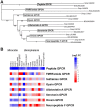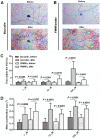Analysis of rhodopsin G protein-coupled receptor orthologs reveals semiochemical peptides for parasite (Schistosoma mansoni) and host (Biomphalaria glabrata) interplay
- PMID: 35581232
- PMCID: PMC9114394
- DOI: 10.1038/s41598-022-11996-x
Analysis of rhodopsin G protein-coupled receptor orthologs reveals semiochemical peptides for parasite (Schistosoma mansoni) and host (Biomphalaria glabrata) interplay
Abstract
Schistosomiasis is a medically significant disease caused by helminth parasites of the genus Schistosoma. The schistosome life cycle requires chemically mediated interactions with an intermediate (aquatic snail) and definitive (human) host. Blocking parasite development within the snail stage requires improved understanding of the interactions between the snail host and the Schistosoma water-borne free-living form (miracidium). Innovations in snail genomics and aquatic chemical communication provide an ideal opportunity to explore snail-parasite coevolution at the molecular level. Rhodopsin G protein-coupled receptors (GPCRs) are of particular interest in studying how trematode parasites navigate towards their snail hosts. The potential role of GPCRs in parasites makes them candidate targets for new antihelminthics that disrupt the intermediate host life-cycle stages, thus preventing subsequent human infections. A genomic-bioinformatic approach was used to identify GPCR orthologs between the snail Biomphalaria glabrata and miracidia of its obligate parasite Schistosoma mansoni. We show that 8 S. mansoni rhodopsin GPCRs expressed within the miracidial stage share overall amino acid similarity with 8 different B. glabrata rhodopsin GPCRs, particularly within transmembrane domains, suggesting conserved structural features. These GPCRs include an orphan peptide receptor as well as several with strong sequence homologies with rhabdomeric opsin receptors, a serotonin receptor, a sulfakinin (SK) receptor, an allatostatin-A (buccalin) receptor and an FMRFamide receptor. Buccalin and FMRFa peptides were identified in water conditioned by B. glabrata, and we show synthetic buccalin and FMRFa can stimulate significant rates of change of direction and turn-back responses in S. mansoni miracidia. Ortholog GPCRs were identified in S. mansoni miracidia and B. glabrata. These GPCRs may detect similar ligands, including snail-derived odorants that could facilitate miracidial host finding. These results lay the foundation for future research elucidating the mechanisms by which GPCRs mediate host finding which can lead to the potential development of novel anti-schistosome interventions.
© 2022. The Author(s).
Conflict of interest statement
The authors declare no competing interests.
Figures




Similar articles
-
GPCR and IR genes in Schistosoma mansoni miracidia.Parasit Vectors. 2016 Oct 26;9(1):563. doi: 10.1186/s13071-016-1837-2. Parasit Vectors. 2016. PMID: 27784323 Free PMC article.
-
Compatibility Polymorphism Based on Long-Term Host-Parasite Relationships: Cross Talking Between Biomphalaria glabrata and the Trematode Schistosoma mansoni From Endemic Areas in Brazil.Front Immunol. 2019 Apr 9;10:328. doi: 10.3389/fimmu.2019.00328. eCollection 2019. Front Immunol. 2019. PMID: 31024517 Free PMC article.
-
A new accumulation assay of Schistosoma mansoni miracidia using square capillary glass tubes.Exp Parasitol. 2022 Aug;239:108313. doi: 10.1016/j.exppara.2022.108313. Epub 2022 Jun 23. Exp Parasitol. 2022. PMID: 35753412
-
Epigenetic modulation, stress and plasticity in susceptibility of the snail host, Biomphalaria glabrata, to Schistosoma mansoni infection.Int J Parasitol. 2016 Jun;46(7):389-94. doi: 10.1016/j.ijpara.2016.03.003. Epub 2016 Apr 4. Int J Parasitol. 2016. PMID: 27056272 Review.
-
Immuno-molecular profile for Biomphalaria glabrata/Schistosoma mansoni interaction.Dev Comp Immunol. 2024 Jan;150:105083. doi: 10.1016/j.dci.2023.105083. Epub 2023 Oct 17. Dev Comp Immunol. 2024. PMID: 37852455 Review.
Cited by
-
Genome-wide identification and functional characterization of GPCR family genes reveal their key roles in the vitellarium development and egg production in Schistosoma japonicum.Parasit Vectors. 2025 Jul 17;18(1):286. doi: 10.1186/s13071-025-06929-2. Parasit Vectors. 2025. PMID: 40676690 Free PMC article.
-
The FMRF-NH2 gated sodium channel of Biomphalaria glabrata: Localization and expression following infection by Schistosoma mansoni.PLoS Negl Trop Dis. 2023 Jun 23;17(6):e0011249. doi: 10.1371/journal.pntd.0011249. eCollection 2023 Jun. PLoS Negl Trop Dis. 2023. PMID: 37352363 Free PMC article.
-
Application of microphysiological systems to unravel the mechanisms of schistosomiasis egg extravasation.Front Cell Infect Microbiol. 2025 Feb 18;15:1521265. doi: 10.3389/fcimb.2025.1521265. eCollection 2025. Front Cell Infect Microbiol. 2025. PMID: 40041145 Free PMC article. Review.
-
Making sense of sensory behaviors in vector-borne helminths.Trends Parasitol. 2022 Oct;38(10):841-853. doi: 10.1016/j.pt.2022.07.003. Epub 2022 Aug 2. Trends Parasitol. 2022. PMID: 35931639 Free PMC article. Review.
-
Form and Function in the Digenea, with an Emphasis on Host-Parasite and Parasite-Bacteria Interactions.Adv Exp Med Biol. 2024;1454:3-45. doi: 10.1007/978-3-031-60121-7_1. Adv Exp Med Biol. 2024. PMID: 39008262 Review.
References
-
- Lozano R, Naghavi M, Foreman K, Lim S, Shibuya K, Aboyans V, Abraham J, Adair T, Aggarwal R, Ahn SY. Global and regional mortality from 235 causes of death for 20 age groups in 1990 and 2010: A systematic analysis for the Global Burden of Disease Study 2010. The Lancet. 2013;380(9859):2095–2128. doi: 10.1016/S0140-6736(12)61728-0. - DOI - PMC - PubMed
-
- Ittiprasert, W., Myers, J., Odoemelam, E. C., Raghavan, N., Lewis, F., Bridger, J. M., & Knight, M. Advances in the Genomics and Proteomics of the Freshwater Intermediate Snail Host of Schistosoma mansoni, Biomphalaria glabrata. In: Biomphalaria Snails and Larval Trematodes. edn.: Springer; 2011: 191–213.
Publication types
MeSH terms
Substances
Grants and funding
LinkOut - more resources
Full Text Sources
Research Materials

